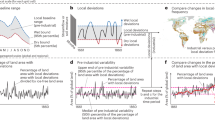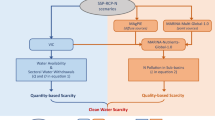Abstract
Although there is overwhelming evidence showing that human emissions are affecting a wide range of atmospheric variables1, it is not clear whether anthropogenic climate change is detectable in continental-scale freshwater resources. Owing to the complexity of terrestrial hydro-systems there is to date only limited evidence suggesting that climate change has altered river discharge in specific regions2,3,4,5. Here we show that it is likely6 that anthropogenic emissions have left a detectable fingerprint in renewable freshwater resources in Europe. We use the detection and attribution approach1,7 to compare river-flow observations8 with state-of-the-art climate model simulations9. The analysis shows that the previously observed amplification of the south (dry)–north (wet) contrast in pan-European river flow10 is captured by climate models only if human emissions are accounted for, although the models significantly underestimate the response. A regional analysis highlights that a strong and significant decrease is observed in the Mediterranean, generally along with a weak increase in northern Europe, whereas there is little change in transitional central Europe. As river and streamflow are indicators for renewable freshwater resources11,12,13, the results highlight the necessity of raising awareness on climate change projections5,14 that indicate increasing water scarcity in southern Europe.
This is a preview of subscription content, access via your institution
Access options
Access Nature and 54 other Nature Portfolio journals
Get Nature+, our best-value online-access subscription
$29.99 / 30 days
cancel any time
Subscribe to this journal
Receive 12 print issues and online access
$209.00 per year
only $17.42 per issue
Buy this article
- Purchase on Springer Link
- Instant access to full article PDF
Prices may be subject to local taxes which are calculated during checkout



Similar content being viewed by others
References
Bindoff, N. L. et al. in Climate Change 2013: The Physical Science Basis (eds Stocker, T. F. et al.) 867–952 (IPCC, Cambridge Univ. Press, 2013).
Barnett, T. P. et al. Human-induced changes in the hydrology of the Western United States. Science 319, 1080–1083 (2008).
Hidalgo, H. G. et al. Detection and attribution of streamflow timing changes to climate change in the Western United States. J. Clim. 22, 3838–3855 (2009).
Mondal, A. & Mujumdar, P. P. On the basin-scale detection and attribution of human-induced climate change in monsoon precipitation and streamflow. Wat. Resour. Res. 48, W10520 (2012).
Seneviratne, S. I. et al. in Managing the Risks of Extreme Events and Disasters to Advance Climate Change Adaptation (eds Field, C. B. et al.) 109–230 (IPCC, Cambridge Univ. Press, 2012).
Cubasch, U. et al. in Climate Change 2013: The Physical Science Basis (eds Stocker, T. F. et al.) 119–158 (IPCC, Cambridge Univ. Press, 2013).
Allen, M. R. & Stott, P. A. Estimating signal amplitudes in optimal fingerprinting, part I: theory. Clim. Dynam. 21, 477–491 (2003).
Gudmundsson, L. & Seneviratne, S. I. Observation-based gridded runoff estimates for Europe (E-RUN version 1.1). Earth System Sci. Data 8, 279–295 (2016).
Taylor, K. E., Stouffer, R. J. & Meehl, G. A. An overview of CMIP5 and the experiment design. Bull. Am. Meteorol. Soc. 93, 485–498 (2011).
Stahl, K., Tallaksen, L. M., Hannaford, J. & van Lanen, H. A. J. Filling the white space on maps of European runoff trends: estimates from a multi-model ensemble. Hydrol. Earth Syst. Sci. 16, 2035–2047 (2012).
Vörösmarty, C. J., Green, P., Salisbury, J. & Lammers, R. B. Global water resources: vulnerability from climate change and population growth. Science 289, 284–288 (2000).
Oki, T. & Kanae, S. Global hydrological cycles and world water resources. Science 313, 1068–1072 (2006).
Shiklomanov, I. A. et al. World Water Resources at the Beginning of the Twenty-First Century (Cambridge Univ. Press, 2004).
Schewe, J. et al. Multimodel assessment of water scarcity under climate change. Proc. Natl Acad. Sci. USA 111, 3245–3250 (2014).
Rockstrom, J. et al. A safe operating space for humanity. Nature 461, 472–475 (2009).
Steffen, W. et al. Planetary boundaries: guiding human development on a changing planet. Science 347, 1259855 (2015).
Jaramillo, F. & Destouni, G. Comment on “Planetary boundaries: Guiding human development on a changing planet”. Science 348, 1217 (2015).
Jaramillo, F. & Destouni, G. Local flow regulation and irrigation raise global human water consumption and footprint. Science 350, 1248–1251 (2015).
Hartmann, D. L. et al. in Climate Change 2013: The Physical Science Basis (eds Stocker, T. F. et al.) 159–254 (IPCC, Cambridge Univ. Press, 2013).
Vörösmarty, C. et al. Humans transforming the global water system. Eos 85, 509–514 (2004).
Fekete, B. M. et al. Time for in situ renaissance. Science 349, 685–686 (2015).
Hurrell, J. W. & VanLoon, H. Decadal variations in climate associated with the North Atlantic Oscillation. Climatic Change 36, 301–326 (1997).
Bouwer, L. M., Vermaat, J. E. & Aerts, J. C. J. H. Regional sensitivities of mean and peak river discharge to climate variability in Europe. J. Geophys. Res. 113, D19103 (2008).
Gudmundsson, L. & Seneviratne, S. I. Anthropogenic climate change affects meteorological drought risk in Europe. Environ. Res. Lett. 11, 044005 (2016).
Sterling, S. M., Ducharne, A. & Polcher, J. The impact of global land-cover change on the terrestrial water cycle. Nat. Clim. Change 3, 385–390 (2013).
Thiery, W. et al. Present-day irrigation mitigates heat extremes. J. Geophys. Res. 122, 1403–1422 (2017).
Lehner, B. et al. High-resolution mapping of the world’s reservoirs and dams for sustainable river-flow management. Front. Ecol. Environ. 9, 494–502 (2011).
Milly, P. C. D. Climate, soil water storage, and the average annual water balance. Wat. Resour. Res. 30, 2143–2156 (1994).
Milly, P. C. D. & Dunne, K. A. Potential evapotranspiration and continental drying. Nat. Clim. Change 6, 946–949 (2016).
Zhang, X. et al. Detection of human influence on twentieth-century precipitation trends. Nature 448, 461–465 (2007).
Vicente-Serrano, S. M. et al. Effect of reservoirs on streamflow and river regimes in a heavily regulated river basin of Northeast Spain. CATENA 149, 727–741 (2017).
ECA & D Project Team & Royal Netherlands Meteorological Institute K. Algorithm Theoretical Basis Document (ATBD) (2013).
Haylock, M. R. et al. A European daily high-resolution gridded data set of surface temperature and precipitation for 1950–2006. J. Geophys. Res. 113, D20119 (2008).
Hargreaves, G. H. Defining and using reference evapotranspiration. J. Irrig. Drain. Eng. 120, 1132–1139 (1994).
Hurrell, J. & National Center for Atmospheric Research Staff (Eds) The Climate Data Guide: Hurrell North Atlantic Oscillation (NAO) Index (station-based). (Modified 7 July 2017); https://climatedataguide.ucar.edu/climate-data/hurrell-north-atlantic-oscillation-nao-index-station-based
Arora, V. K. The use of the aridity index to assess climate change effect on annual runoff. J. Hydrol. 265, 164–177 (2002).
Budyko, M. I. Climate and Life (Academic, 1974).
Fu, B. On the calculation of the evaporation from land surface (in Chinese). Sci. Atmos. Sin. 1, 23–31 (1981).
Zhang, L. et al. A rational function approach for estimating mean annual evapotranspiration. Wat. Resour. Res. 40, W02502 (2004).
Greve, P., Gudmundsson, L., Orlowsky, B. & Seneviratne, S. I. Introducing a probabilistic Budyko framework. Geophys. Res. Lett. 42, 2261–2269 (2015).
Iles, C. E. & Hegerl, G. C. Systematic change in global patterns of streamflow following volcanic eruptions. Nat. Geosci. 8, 838–842 (2015).
Stahl, K. et al. Streamflow trends in Europe: evidence from a dataset of near-natural catchments. Hydrol. Earth Syst. Sci. 14, 2367–2382 (2010).
Sen, P. K. Estimates of the regression coefficient based on Kendall’s tau. J. Am. Stat. Assoc. 63, 1379–1389 (1968).
Theil, H. A rank-invariant method of linear and polynomial regression analysis. Proc. R. Netherlands Acad. Sci. 53, 386–392 (1950).
Yue, S. & Wang, C. The Mann–Kendall test modified by effective sample size to detect trend in serially correlated hydrological series. Wat. Resour. Manage. 18, 201–218 (2004).
Benjamini, Y. & Hochberg, Y. Controlling the false discovery rate: a practical and powerful approach to multiple testing. J. R. Stat. Soc. B 57, 289–300 (1995).
Wilks, D. S. “The stippling shows statistically significant grid points”: how research results are routinely overstated and overinterpreted, and what to do about it. Bull. Am. Meteorol. Soc. 97, 2263–2273 (2016).
Allen, M. R. & Tett, S. F. B. Checking for model consistency in optimal fingerprinting. Clim. Dynam. 15, 419–434 (1999).
Acknowledgements
This research contributes to the European Union funded EUCLEIA project (contract no. 6070085). Partial support of the ERC DROUGHT-HEAT project (contract no. 617518) is acknowledged. The efforts to assemble the European Water Archive (EWA) by the UNESCO IHP VII FRIEND programme, the data collection and management by the GRDC, and the provision of data by Spanish authorities are gratefully acknowledged. We acknowledge the E-OBS dataset from the EU-FP6 project ENSEMBLES (http://ensembles-eu.metoffice.com) and the data providers in the ECA&D project (http://www.ecad.eu). We thank J. Sedlacek and U. Beyerle for the retrieval and preparation of CMIP5 model data.
Author information
Authors and Affiliations
Contributions
L.G. and S.I.S. initiated this project. L.G., S.I.S. and X.Z. designed the study. L.G. carried out the analysis. L.G. wrote the manuscript with contributions from S.I.S. and X.Z. X.Z. contributed to the interpretation and development of the detection and attribution methodology.
Corresponding author
Ethics declarations
Competing interests
The authors declare no competing financial interests.
Supplementary information
Supplementary Information
Supplementary Information (PDF 538 kb)
Rights and permissions
About this article
Cite this article
Gudmundsson, L., Seneviratne, S. & Zhang, X. Anthropogenic climate change detected in European renewable freshwater resources. Nature Clim Change 7, 813–816 (2017). https://doi.org/10.1038/nclimate3416
Received:
Accepted:
Published:
Issue Date:
DOI: https://doi.org/10.1038/nclimate3416
This article is cited by
-
Evidence of human influence on Northern Hemisphere snow loss
Nature (2024)
-
Human-induced intensification of terrestrial water cycle in dry regions of the globe
npj Climate and Atmospheric Science (2024)
-
Caravan - A global community dataset for large-sample hydrology
Scientific Data (2023)
-
Attribution assessment of hydrological trends and extremes to climate change for Northern high latitude catchments in Norway
Climatic Change (2023)
-
Cascading effects of climate change on recreational marine flats fishes and fisheries
Environmental Biology of Fishes (2023)



